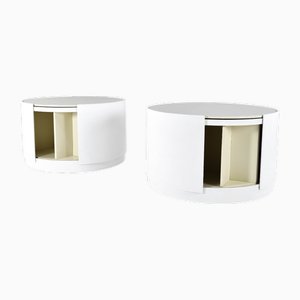
The roots of Italian industrial design company Tecno go back to the early 1920s, when woodworker and upholsterer Gaetano Borsani (1886-1955) set up Atelier Borsani Varedo (later called Arredamenti Borsani Varedo) in Varedo, Italy. In those early years, the family business produced fine, bespoke furnishings in a style that reflected the Art Deco movement as well as the artisanal traditions of the Brianza region of Lombardy. Participation in the Mostra Internazionale di Arte Decorative exhibitions in Monza earned Atelier Borsani acclaim in 1925, 1927, and 1930.
Gaetano’s twin sons Fulgenzio and Osvaldo Borsani took active roles in the company from an early age. While still studying architecture at Beaux-Arts Accedemia di Brera, Osvaldo designed a rationalist furniture collection, called Casa Minima, and presented it at the 5th Triennale di Milano in 1933. The project won a silver medal. Throughout the ’30s and ’40s, Atelier Borsani was commissioned by Lombardy’s elite society to create furniture for large and upscale domestic and office interiors.
Following the Second World War, Osvaldo began to envision transitioning his family’s business from traditional craft production to industrial manufacturing—even though his father Gaetano did not like the idea. Osvaldo remained determined to use modernist principles to design for the changing lifestyles of the postwar era. Together with his brother Fulgenzio, Osvaldo founded a new company, Tecno, in 1953.
Tecno’s first factory-produced collection of sofas, chairs, and tables received an enthusiastic reception at the 10th Triennale di Milano in 1954. The simple, adjustable D70 Sofa Bed (1954) received honorable mention, and Osvaldo promptly patented the design. Tecno’s next big hit was the P40 Lounge (1956), an adjustable, reclining chair with built-in footrest. Both of these Tecno products have become beloved symbols of the golden age of Italian modernist design.
While Osvaldo was inspired by the functionalist theories of the pioneers of modernism that practiced the generation before him, the flexibility and multipurpose capacities of Tecno’s earliest designs can also be traced to the work produced by Atelier Borsani Varedo. Gaetano’s success was built upon creating well made, customized, and adaptable furnishings. Osvaldo’s primary aim, in contrast to his father’s, was to take smart design solutions to the masses, especially in the context of office buildings and public spaces, like train stations, airports, and hospitals.
In 1957, Osvaldo received his first first large-scale commission to design office furniture for ENI, the Italian multinational oil and gas company. More major commissions followed, and Tecno became internationally known for designs based in advanced technology.
In 1968, Tecno introduced the Graphis Office System (1967)—designed by Osvaldo Borsani and Eugenio Gerli (b. 1923)—at the 14th Triennale di Milano; it was heralded as a revolution in office furniture design because the system’s modular components allowed unlimited and customizable combinations that adapt overtime as companies grow and contract. It remained a bestseller for Tecno for decades.
In 1970, as Osvaldo began to step away from day-to-day operations and his son-in-law, Marco Fantoni, took a larger role—Tecno restructured its design approach. Underscoring the collaborative effort that goes into developing new designs, Tecno launched its Centro Progetti Tecno, an in-house team dedicated to communications and industrial design work. The Centro Progetti Tecno was responsible for a number of the company’s successes in the ’70s and ’80s, including the molded plastic Modus Office Chair (1972), which won the SMAU Prize in 1973; the steel mesh Waiting System (1983), a modular seating and table concept for large public spaces; and the rebranding of Alitalia worldwide (1982-84), for which Centro Progetti Tecno was award the Compasso d’Oro in 1984.
In the 1980s, Tecno began to commission outside designers to produced furniture designs—an approach that continues to this day. Highlights include Norman Foster’s Nomos Tables (1986); Luca Scacchetti’s Ianus Desk and Storage System (1988); Emilio Ambasz’s Qualis Chairs (1991), Piero Lissoni ‘s Asymmetrical System (2006); Rodolfo Dordoni’s PONS D011 Sofa and Table System (2011); Monica Förster’s Archipelago D502 Seating System (2012); and Luca Scacchetti’s Vara T503 Tables and Storage System (2013).
Tecno has also found success cultivating long-term partnerships with leading architects, who have commissioned Tecno to provide tailor-made furniture solutions for landmark buildings, such as Foster + Partners’ refurbished British Museum in London and Jean Nouvel's Agbar Tower in Barcelona.
In 2008, Tecno opened new Milan offices in the Porta Garibaldi Excise Buildings, following extensive adaptation and refurbishment work. Today, many Tecno products can be found in the collections of leading museums around the world such as New York, SF MoMA, Victoria & Albert London, Pompidou Centre Paris, Neue Sammlung Monaco, Museum of Decorative Arts Montreal, and Triennale Milano.

